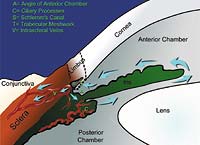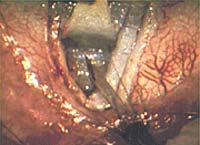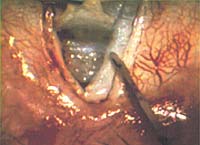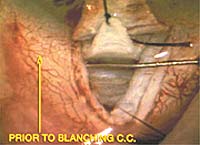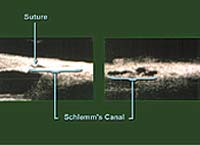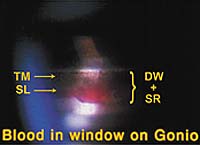Viscocanalostomy highly successful, with enduring results
Concurrent cataract surgery "quiet" because of compartmentalization.
JOHNSTOWN, N.Y. - After performing approximately 300 viscocanalostomy procedures in the past 3 years, "I believe viscocanalostomy is a much better procedure than trabeculectomy," said John R. Kearney, MD, an ophthalmologist in private group practice here.
"Between 85% and 90% of patients have their intraocular pressures controlled without drops," Dr. Kearney said. These results are gratifying because "I feel that using a lot of medications, long term, is detrimental to the eye and that systemically many of these medications are harmful," he said.
|
|
Viscocanalostomy is a glaucoma surgical procedure that restores normal physiology by internal filtration of aqueous flow, Dr. Kearney said. The procedure reroutes aqueous flow through a newly created window in Descemet's membrane, thus bypassing the trabecular meshwork.
The standard glaucoma procedure, trabeculectomy, has both "a high failure rate and a high complication rate," Dr. Kearney said. "There are no intentional filtering blebs with the viscocanalostomy. Therefore, you avoid the bleb problem of endophthalmitis."
However, Dr. Kearney said performing a viscocanalostomy is technically demanding, difficult, delicate and precise. Surgeons familiar with trabeculectomy "are not used to working at high [magnification] power.
Viscocanalostomy requires a different approach to anatomy," he said. One step, in particular, "is the key in making the rest of the procedure consistent." That step is a deep sclerectomy dissection. "At the apex, cut all the way down to the ciliary body, so you can actually see the ciliary body," Dr. Kearney said. "Then, you back up a few fibers - 50 to 100 µm - and begin your planar dissection forward from there." By doing this, a surgeon will enter "Schlemm's canal every time. The hardest part of the overall procedure is getting into Schlemm's canal consistently. Once you get into the canal, though, the rest of the procedure is fairly straightforward," he said.
Patient guidelines
|
|
Dr. Kearney said viscocanalostomy "works in almost all types of glaucoma. One exception is neovascular glaucoma." Dr. Kearney prefers to operate on patients whose IOP is not controlled by three glaucoma medications or patients undergoing cataract surgery who are not well controlled by two medications.
Success is defined as an IOP equal to or less than 22 mm Hg and no glaucoma medications. In Dr. Kearney's practice, this success has been achieved by 85% of black patients, 90% of whites, 90% to 95% of patients on beta-blockers and 93% to 97% of patients operated on with Healon GV viscoelastic (sodium hyaluronate, Pharmacia).
Besides the high percentage of patients who no longer require medications nor experience high pressure spikes, Dr. Kearney says that viscocanalostmy avoids any implant or valve problems. Furthermore, "I have had no blebs, no leaking blebs, no hypotony, no choroidal effusions, no retinopathies, no failed blebs, no cystic blebs and no late endophthalmitis," he said. "These are all complications that can occur with trabeculectomy."
Moreover, "there is no hyphema, no uveitis and no peripheral anterior synechiae," Dr. Kearney said. And although the procedure takes longer than trabeculectomy - 45 to 60 minutes compared to 10 to 15 minutes - "there is less postoperative time and fewer postoperative visits," he said.
Cataract surgery
|
|
|
|
|
|
Because viscocanalostomy does not involve entering the anterior chamber, compartmentalization of the eye is also maintained. "Concurrent cataract surgery is quiet because of compartmentalization," said Dr. Kearney, who recommends performing a superficial flap first to reduce bleeding. "With concurrent cataract surgery, I am seeing an 85% to 90% success rate, compared to 65% to 70% with a trabeculectomy. But it depends on your population group. If you have a high black population, your success rate for trabeculectomy is going to be a lot lower."
Most failures with viscocanalostomy stem from perforating Descemet's membrane. "If you rupture the window, you must perform a peripheral iridectomy if there is a large rupture. By not doing this, you are likely to have a failure," Dr. Kearney said. For a small opening, "I use pilocarpine and phenylephrine to constrict the pupil and pull it tight like a drumhead. This prevents the peripheral anterior synechiae." Patients who have been on miotic drops or epi drops can also experience failure. "In these patients, the eye is usually inflamed," Dr. Kearney said. Therefore, "patients need to be off those drops for 6 to 8 weeks preoperatively."
Two patients have also failed the procedure by not properly using their anti-inflammatory medications postop. A third patient "rubbed the eye and ruptured Descemet's window," Dr. Kearney said.
Since performing his first viscocanalostomy, Dr. Kearney has not done a single trabeculectomy. "I am so happy with the results," he said. In fact, "if I had glaucoma in my own eye, I would want viscocanalostomy as the primary procedure. I would also desire it for my mother's eye."
For Your Information:
- John R. Kearney, MD, can be reached at Cataract Care Center, 135 County Highway 128, Johnstown, NY 12095; (800) CATARACT; fax: (518) 762-2022; e-mail: ccc@superior.net. Dr. Kearney has no direct financial interest in any products mentioned in this article, nor is he a paid consultant for any companies mentioned.

